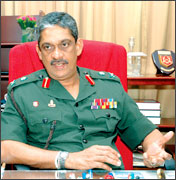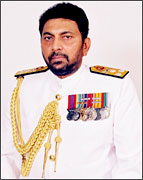Nation marches forward
Development at a pace while bulldozing terrorism:
By Dhaneshi Yatawara
[email protected]
 Addressing the Srilankan AirLines employees last week President
Mahinda Rajapaksa reiterated that we are integrating our country to the
world economy keeping our identity intact. It is the duty of every
citizen to protect the motherland keeping our uniqueness unharmed. Addressing the Srilankan AirLines employees last week President
Mahinda Rajapaksa reiterated that we are integrating our country to the
world economy keeping our identity intact. It is the duty of every
citizen to protect the motherland keeping our uniqueness unharmed.
With a vision towards a prosperous new Sri Lanka, amidst many debates
and fiascos we are moving forward providing opportunities to all from
social and economic empowerment focusing on balanced sustainable
development in the village, region and country to ethnic harmony and
peace. At times the process may become slow, at times it is swift - yet
we are steady.
President Mahinda Rajapaksa, in a message to the Ministry of Nation
Building and Estate Infrastructure Development in their performance
evaluation 2007 stated: “I strongly believe that minimising the
deficiencies in the regional development and converting all sections of
the people as stakeholders of the national development process among the
people is the crust of the development.” This is the vision of a leader.
In the process of rebuilding and empowering of the nation there are
three main objectives - provision of infrastructure facilities,
improvement of livelihoods and moral uplift of the village community.
The village is considered as the axis of national development and the
‘Mahinda Chinthana’ clearly emphasises that achievement of national
development is desired and required through successful development of a
village.
Projects like the ‘Gama Neguma’ are implemented through three main
pivots - i.e. construction and improvements of infrastructure
facilities, establishment of livelihoods and creation of a virtuous
society in the villages.
According to the Nation Building Ministry during last year, 4968
development projects were launched in 4172 villages and are in progress
with an investment of Rs. 4000 million. With an objective of maximum
devotion towards nation building the relevant requisite planning is
already under way to cover all the villages in the island during the
next year.
‘Neganahira Navodaya’ - the Eastern resurgence, is the lead programme
incorporating the core components of the ‘Mahinda Chinthana’ the 10-year
horizon development frame work 2006 - 2016: the vision for a new Sri
Lanka.
It consists of the liberation of the Eastern region, restoration of
law and order, restoration of civil administration, equitable resource
allocation among all communities and speedy implementation of programmes
such as the demining action programme, resettlement of IDPs,
reconstruction of damaged social and economic infrastructures, promotion
of industrial development with private sector participation etc.
According to statistics, 48,651 families have already been resettled
in the Eastern Province up to 2007. In the Eastern theater alone during
the past year, 116 projects have been implemented for the agriculture
sector with a total estimated cost of Rs. 185.83 million.
For Education 139 projects with a total estimated cost of Rs. 190.94
and for health 87 with an estimated cost of 275.21 million rupees.
The main component of the Eastern revival includes linking and
supportive infrastructural projects, which are aimed at improving
mobility and accessibility at regional level.
These projects also aim to improve the capacity of the regions to
link with the mainstream of development. These have a catalytic role in
boosting commercial activities in Ampara, Batticaloa and Trincomalee.
During the next 10 years, Sri Lanka’s population is expected to
increase from the present (2005) level of 19.7 million to about 22
million. The labour force will reach a level of about 10.9 million. The
unemployment rate has already declined to around 7 percent.
There could be something tightening of the labour market conditions
with the possible increased demand for labour with the ongoing expansion
of the world economy, ageing population in many countries including Sri
Lanka and expected expansion of domestic economy.
“However, we need to ensure that gains made in employment are
sustained and the new entrants to the labour force, projected to be
around 2.8 million during the next 10 years are well prepared to be
gainfully employed and their productivity level raised.
Another major challenge will be to eradicate poverty, affecting about
23 percent of the countries population.” Mahinda Chinthana - discussion
paper on development framework 2006 - 2016.
Randora, the national infrastructure development programme of the
Government aims to provide modern infrastructure to promote nation-wide
economic development, create income-earning opportunities and promote
new avenues for investment.
As envisaged in the Mahinda Chinthana: Vision for a new Sri Lanka - A
Ten- Year Horizon Development Framework 2006-2016, the implementation of
projects under Randora will contribute towards strengthening competition
of Sri Lankan enterprises and improving business initiatives and place
Sri Lanka’s economic growth in excess of 8 percent.
The implementation of mega power projects such as the Norochcholai
and Trincomalee Coal Fired Power Plants, mega Ports and Aviation
development projects such as the expansion of the Colombo and Galle
Ports, new Ports in Hambantota and Oluvil, the new International Airport
in Weeravila and urban infrastructural development projects such as the
development of Expressways, National Highways and Rail Networks will
transform Sri Lanka’s landscape into a regional growth centre.
Investments in the Education and Health infrastructure will
contribute towards the creation of a healthy and skillful labour force
required to achieve rapid economic growth.
The implementation of Randora projects will create direct and
indirect income generating opportunities and enable Sri Lanka to fully
comply with the Millennium Development Goals (MDGs) by 2015.
According to the annual Asian Development Outlook published in March
2008 by the Asian Development Bank, the Sri Lankan economy has proven to
be more resilient than expected by most observers, both local and
international.
Though the economy slowed in 2007, it still showed a robust growth of
an estimated 6.7 percent, it said. The trend of strong remittances
growth since 2004 continued in 2007 to support the current account
balance of payments.
Remittances counterbalanced the continued high trade deficit, which
fell slightly from 2006 level, on account of lower import growth and a
strong export performance (mainly garments).
The overall balance of payments improved considerably in 2007,
recording a surplus of $ 570 million. The improvement was largely due to
a $ 500 million sovereign bond issue. However, global food and oil price
increases, in combination with expansionary macroeconomic policies, have
doubled inflation, it said.
It is said that when dangers are great, the greatest honours are to
be won by men and the states. Yes we have a great threat. Yet we have
the most admirable and well-trained men and women to secure the nation
and the future.
The future we are planning for 10 years or more are difficult. Yet
these brave men and women need to be with us as we are fighting against
a ruthless terrorism - one of the most fearsome in the world — the LTTE.
The ongoing clashes have affected mostly the entire Northern and the
Eastern parts of our island nation during a little less than a quarter
century in varying degrees while imposing a heavy cost on the economy in
the forms of resources wasted and lost opportunities.
Men think same way as the leaders think
Lieutent General Sarath Fonseka -Commander of the
Army
 “Removing the threat of terrorism is of high priority since
terrorists are a group who pose a threat to the sovereignty and the
territorial integrity of the country - which no nation can afford to
lose.Probably they themselves would disarm and come to normal life. “Removing the threat of terrorism is of high priority since
terrorists are a group who pose a threat to the sovereignty and the
territorial integrity of the country - which no nation can afford to
lose.Probably they themselves would disarm and come to normal life.
Yet, even if that does happen we are given this uniform and a weapon
to protect our Motherland from such threats and we will not fail in our
duty. Apart from the military strategies we see the Government taking
immense measures to suppress the false propaganda spread by the LTTE
internationally whilst being in search of a long lasting political
solution.
Our job is to fight against those who are carrying weapons illegally
and posing a threat to the sovereignty of our country. Eastern
liberation paved the way to the Government to re-establish civil
administration in the East without any interference from the terrorists.
Our achievements are major blows to the LTTE as their claim for the
North and East for a separate state has now become only a dream.”
Vice Admiral Wasantha Karannagoda - Commander of the Navy
 Sri Lanka Navy being the first line of defence marked a number of
important victories against the LTTE Sea Tiger wing and was able to
starve the LTTE militarily by destroying their floating warehouses and
cutting off sea supply lines since the beginning of the Mavil Aru
humanitarian mission to the present day. Sri Lanka Navy being the first line of defence marked a number of
important victories against the LTTE Sea Tiger wing and was able to
starve the LTTE militarily by destroying their floating warehouses and
cutting off sea supply lines since the beginning of the Mavil Aru
humanitarian mission to the present day.
After carefully analysing the Sea Tiger tactics, the navy launched
their hunter-killer operations which resulted in capturing and
destroying a large number of LTTE multi-day fishing trawlers which
engaged in smuggling war like material.
The Fast Attack Craft too played an important role by placing round
the clock sea blockades to avoid sea Tiger reinforcements reaching East
and also avoided LTTE withdrawal via sea.
This was followed by the destruction of eight floating warehouses of
the LTTE during the past two years. The destruction of these Tiger
vessels and naval blockades had a direct impact on the past humanitarian
missions launched by the ground troops and even in today’s operations.
In addition to having a direct impact on the ground operations, those
deep-sea victories assisted in countering international maritime
terrorism too. In short the Navy operations in the deep seas have
destroyed the LTTE international maritime network, which had routes
running to many parts of the world inflicting severe blow to the LTTE’s
international arms smuggling. |
